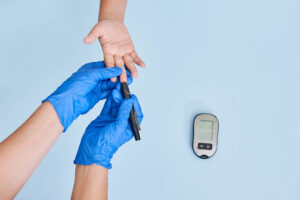Diabetes mellitus (DM) is a heterogeneous metabolic disorder that is characterized by the common point of chronic hyperglycemia (high levels of glucose in the blood)with disturbance of carbohydrate, fat, and protein metabolism. Diabetes beget morbidity and mortality all over the world. It is estimated that approximately 1% of the population suffers from Diabetes mellitus. Diabetes is anticipated to continue as a major health problem owing to its serious complications, especially end-stage renal disease, cardiovascular diseases, etc.
Diabetes is caused due to either the pancreas not producing the required amount of insulin or the cells of the body not responding to the insulin produced(insulin resistance).
What are normal blood glucose levels?
Less than 100 mg/dL fasting (before meal)
Less than 140 mg/dL two hours after the meal
What are abnormal blood glucose levels?
More than 130 mg/dL before meals
More than 190 mg/dL two hours after meals
PRE-DIABETES:
• It’s a condition where the person is not diabetic but the blood glucose levels are
advanced than normal.
• 140-199 mg/dL is the indication of pre-diabetes
• people are more prone to get pre-diabetes due to being overweight, lifestyle,
polycystic ovary syndrome (POCS).
Lower Back Pain: Tips for Relief and Prevention. Click here To Read This Article
SYMPTOMS OF DIABETES MELLITUS:
Symptoms may develop rapidly(weeks Or months)in type 1 DM and slowly in type 2 DM
• Frequent urination(polyuria)
• Increased thirst(polydipsia)
• Increased hunger(polyphagia)
• Itchy skin
• Loss of weight
• Blurred vision
• Feeling fatigue
TYPES OF DIABETES MELLITUS:
Types of diabetes mellitus are mainly categorized as
i. Primary Diabetes mellitus
ii. Secondary Diabetes mellitus
PRIMARY DIABETES MELLITUS:
Primary diabetes mellitus is also known as Idiopathic Diabetes.
TYPE 1 DIABETES MELLITUS:
- It’s also called insulin-dependent diabetes mellitus (IDDM) Or also called Juvenile Diabetes
- Type 1 DM is an autoimmune condition.
- In this type, insulin-producing cells are destroyed thus eliminating insulin
production. - Loss of the insulin-producing beta cells
- in up to 10% of people who have DM Type 1
- It’s usually diagnosed more in children and in youthful grownups.
- people with Type 1 DM need to take Insulin every day. This is why it’s called IDDM
causes of type 1 diabetes mellitus
o Autoimmune diseases
o Genetic factors
o Chemical toxins
o Viral Or bacterial infections
TYPE 2 DIABETES MELLITUS:
- It’s also called Non-insulin-dependent diabetes mellitus(NIDDM) or also called adult-onset diabetes
- Occurs at any age but is more common in people older than the age of 40 Years
- In this type of DM no loss/ only moderate reduction of beta mass
causes of type 2 diabetes mellitus
o High blood pressure
o Pancreatic diseases
o Genetic predisposition
o Stress
o Obesity
o Age
o Lifestyle
o Unhealthy foods
GESTATIONAL DIABETES MELLITUS:
- A rise in blood sugar level in pregnancy is called gestational diabetes mellitus
- This type of DM occurs during pregnancy without a former history of diabetes.
- Hormonal changes during pregnancy can lead to Blood sugar elevation in
predisposed Individualities - It occurs in about 2-10% of all pregnancies and may ameliorate or vanish after
delivery.
SECONDARY DIABETES MELLITUS:
- Known cause of DM
- 2° to another medical condition
- Develops when the pancreatic tissue responsible for the production of Insulin is
destroyed.
Chronic pancreatitis
Surgical removal of the pancreas
Trauma
Acromegaly
Cushing’s syndrome
COMPLICATIONS OF DIABETES MELLITUS:
All forms of diabetes increase the threat of long-term complications. These typically
develop after many years (10-20 years) includes,
• Damage to blood vessels
• Cardiovascular disease
• Macrovascular disease (stroke)
• Peripheral vascular disease
• Eye disease called retinopathy
• Foot pain and the ulcers
• Kidney diseases
DIAGNOSIS OF DIABETES MELLITUS:
Diabetes mellitus can be diagnosed by demonstrating any one of the following tests:
1. Fasting blood glucose test:
This test measures the fasting blood glucose situation in the body. This test is
generally done in the morning.
Normal: less than 100mg/dL
Pre-diabetes: 100-125mg/dL
Diabetes:126mg/dL or high
2. Oral glucose tolerance test(OGTT):
• Measures the body’s capability to metabolize glucose
• Utmost is generally done to check for gestational diabetes.
• The case is asked to take a glucose drink and their blood glucose position is
measured before and at intervals after the sticky drink is taken.
• For the standard value of the glucose tolerance test, we should drink at least 75 grams
or 100 grams.
Normal: less than 140mg/dL
Pre-diabetes:140-199mg/dL
Diabetes:200mg/dL
3. Random plasma glucose test:
During severe diabetes symptoms, a blood test can be done to know the plasma
the glucose level at any period of time.
4. HbA1C test:
• This test is also knowns as the A1C test Or glycated hemoglobin test.
• This test provides information on the average blood glucose position over the history
2 to 3 months.
Normal: less than 5.7%
Pre-diabetes: 5.7 -6. 4%
Diabetes:6.5% or high
MANAGEMENT AND TREATMENT OF DIABETES MELLITUS:
Management and Treatment of DM The major thing in treating diabetes is to keep blood sugar situations as close to normal as possible, without causing
abnormally low levels of blood.
Click Here To Buy
1. Lifestyle habits
- Life variations are the foundation of the operation of diabetes mellitus and include a healthy diet( high protein and low carbohydrate and fat diet), operation of stress, avoidance of alcohol and tobacco, etc. are set up to be effective to control diabetes along with drugs.
- Type I diabetes can be treated with insulin, exercise, and a diabetic diet.
- Type II diabetes can be treated first with weight reduction, a diabetic diet, and exercise.
- Cases with type I diabetes mellitus bear lifelong insulin remedies. Utmost bear 2 or further injections of insulin daily, with dose adjustment on the basis of self-monitoring of blood glucose situations.
- Beforehand induction of pharmacologic remedy is associated with bettered glycaemic control and reduced long-term complications in type II diabetes.
2. Medication:
- The classes of medication used for the treatment of type II diabetes include,Metformin: Generally, metformin is the first medicine specified for type II diabetes. It works by perfecting the perceptivity of body tissues to insulin so that, the body uses insulin more effectively. Metformin also lowers glucose production in the liver.
Sulfonylurea: These specifics help the body secret more insulin
3. Insulin therapy:
Insulin is the main treatment for people with type 1 diabetes mellitus. Some
people who have type 2 diabetes also need insulin in some cases. It replaces the hormone which our body is not able to produce.
According to the duration of action, insulin injections are categorized as
• Rapid-acting insulin
• Short-acting insulin
• Intermediate-acting insulin
• Long-acting insulin
• Ultra-long-acting insulin
4. Transplantation/surgery:
• Pancreas transplantation
• Kidney transplantation
• Surgery for weight loss


